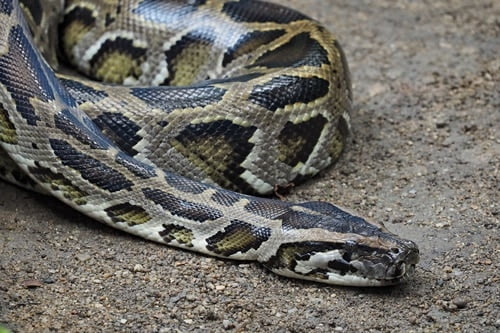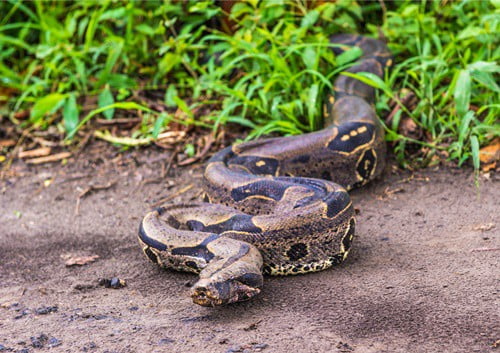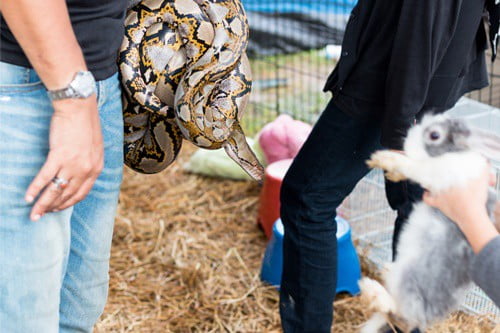The physical safety of your rabbits is vitally important due to the risk posed by predators. So, providing secure housing is an excellent way to protect rabbits from snakes.
Build a sturdy wooden hutch as this will be significantly harder for predators to access. You must also remove any hiding places for snakes, such as plants and bushes near your rabbit’s hutch. The best way to keep rabbits safe from snakes is to house them indoors.
Snakes are obligate carnivores and will eat any meat, including rabbits. Larger snakes, such as boas and pythons, can easily swallow an adult rabbit. Rattlesnakes and other venomous snakes also pose a serious threat to rabbits, especially to rabbit kits. If you keep your rabbits outside, you’ll need to take steps to keep snakes out of their hutch.
How To Keep Rabbits Safe from Snakes
Your rabbit hutch is a major attraction for snakes because it provides easy access to food, shelter, and water. However, snakes and rabbits can never cohabit peacefully. Rabbits, especially rabbit kits, make easy meals for snakes. The safety of your pet rabbit depends on a few factors, such as:
- The type of snake lurking around your rabbit hutch
- The location of your rabbit hutch
- The durability and safety of the hutch
Consider Keeping Your Rabbit Indoors
Rabbits are traditionally kept outside in a hutch because we are so used to seeing wild rabbits hopping around in the great outdoors. This drives owners to believe that even pet rabbits need to be kept outside. Here are a few factors caretakers must consider:
- Daytime only. Only keep rabbits outside during the daytime due to a lower risk of predators. However, you must keep in mind that rabbits can easily die of shock from the mere sight of a snake, fox, or neighborhood cat.
- Survival skills. Domesticated rabbits do not have the same skills and instincts as wild rabbits. Rabbits are bottom of the food chain, and these skills allow them to survive predation in the wild. Pet rabbits are not suited to extreme conditions, isolation, and surprises from predators.
- Sturdy hutch. If you cannot keep your rabbits indoors, proper preparation, care, and a sturdy hutch can keep predators at bay.

Proper Housing To Protect Rabbits From Snakes
A sturdy wooden hutch offers the best form of protection against predators, such as snakes.
Wire cages are a popular choice but are not strong enough to protect rabbits outdoors. A hungry predator looking to hunt your rabbits can easily break into a wire cage.
You can protect your rabbit’s sleeping quarters with a strong wooden floor. The outer region can be fortified with two wire meshes and one wooden wall. For hutches with wooden floors, its advisable to use ½ inch by 1 inch welded wire.
Ensure that the hutch is easily accessible for feeding and cleaning. You can include a catch tray in your design. A catch tray can be pulled out at the bottom of the hutch, making it easier to clean.
To keep snakes away from your rabbit, make sure that the hutch is not directly on the ground. Raise the hutch about 2-3 feet above the ground and secure the bottom of the hutch with sturdy wooden flooring. Secure your rabbit’s hutch to the side of a building, such as your barn or house.
Before Building Your Rabbit Hutch
Make sure that your rabbit hutch is placed in a shaded area, where it is well-protected from the sun. Heat and sun exposure are among the biggest threats to outdoor rabbits.
Rabbits are highly sensitive to heat and prone to dehydration. Keeping a hutch in direct sunlight can be hazardous to their health.
You’ll also want to protect your rabbit hutch from wind and rain. Rabbits are susceptible to pneumonia, so making sure that their hutch is in a protected area will keep them comfortable. If the sides of your rabbit hutch are made of wire, placing curtains around the outside, especially during cold and windy conditions can keep rabbits safe.
Fresh air is vital for rabbits. Therefore, always remember to keep at least one side of the hutch uncovered for ventilation.

Additional Tips To Protect Rabbits From Snakes
If you have a wooden hutch and need extra protection from snakes, consider the following tips:
- Cover all openings in your rabbit hutch. Use wood putty to patch any holes or gaps in the wooden section of the hutch, following the instructions on any product you use. Use hardware cloth over openings larger than ¼ of an inch, such as windows, wire fencing, and ventilation openings.
- Eliminate hiding spots for snakes. Mow your grass short and trim away any plants or bushes on the sides of the rabbit hutch.
- Clean up leftover food. Doing this regularly will prevent the hutch from attracting any snakes or pests.
- Use a non-toxic snake deterrent. Applying a snake deterrent around the rabbit hutch may deter snakes from coming close to your bunnies.
What Types of Snakes Eat Rabbits?
Snakes are carnivorous, which means they only eat meat, including rabbits. Many think that all snakes kill their prey with poison, but this isn’t true. Only vipers, cobras and other related species use venom during hunting. Most snakes will swallow their prey whole.
According to National Geographic, snakes can eat animals that are 75 to 100% bigger than their size. Snakes have been known to eat cows and crocodiles, let alone rabbits. However, some snakes have specific diets, such as snakes belonging to the genus, Dasypeltis that exclusively feed on eggs.
The type of animals snakes consume varies from species to species. While some eat warm-blooded animals, such as rabbits, others will only choose insects, reptiles, fish, and eggs. What snakes eat also depends on the size of the snake, with smaller snakes choosing insects and larger species hunting rabbits, deer, and alligators.
Snakes often target animals that are weaker than them, which is why some species of snakes will only attack rabbit young. It helps to know the type of snakes that are endemic to your region. While some snakes can be potentially dangerous towards rabbits, others may be completely harmless.
| Name of Snake | Where Are They Found? | Diet | How They Hunt |
|---|---|---|---|
| Garter snake |
|
|
|
| Gopher snake |
|
|
|
| Kingsnakes |
|
|
|
| Rattlesnakes |
|
|
|
| Burmese python |
|
|
|
| Southern black racer |
|
|
|
| Brown snake |
|
|
|
| Rat snake |
|
|
|
Do Rabbits Kill Snakes?
When reading about snakes and their hunting techniques, one might feel that a small mammal, such as a rabbit, does not stand a chance against a snake.
However, rabbits have a keen sense of smell, hearing, and sight, which help them defend themselves and their nests from danger.
When a rabbit senses a predator nearby, it will free in place and camouflage with the landscape. Of course, domestic rabbits have a much lower chance of fleeing or surviving an attack from a predator due to their compromised senses.
Sure, rabbits can defend themselves, but can they kill snakes? Rabbits cannot kill snakes. However, some wild rabbits have been found to attack snakes, causing the latter to flee for their lives.
Rabbits may appear as timid animals, but some may surprise you. This is especially true in the case of mother rabbits that are intensely protective of their young. Rabbit kits are weak, slow, and unable to see until almost a week after birth. During this time, they’re easy prey for snakes.

